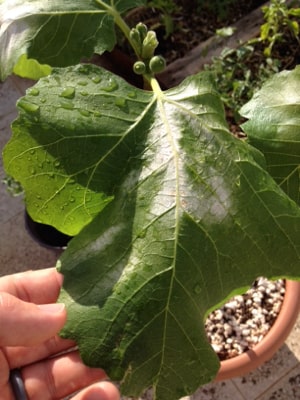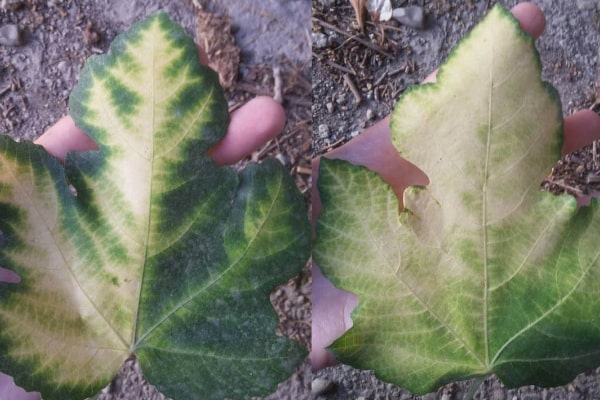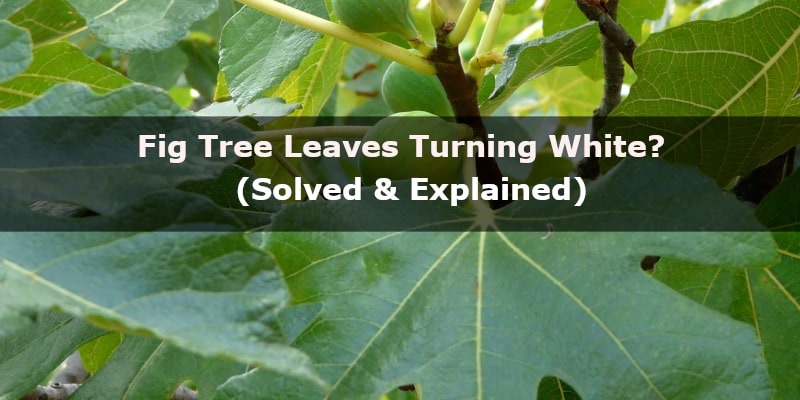If you notice your fig tree leaves are turning white, there might be a few possible reasons behind it.
In this post, you will find out everything about it!
Why are Fig Tree Leaves Turning White?
The most common reason why fig tree leaves are turning white is because of powdery mildew. However, other reasons include scale insect, sunscald, hard water usage or problems with photosynthesis.
There are 5 main reasons why your fig tree leaves are turning white. Each reason leaves white spots on leaves, but the reasons are quite easy to identify.
Some of them are treatable, some not. Keep on reading to find out what causes white leaves on your fig tree!
Powdery Mildew
Powdery mildew is a common fungal disease of fig trees. It starts as small chalky white, or grayish spots that grow larger, and fluffier over time. If you rub it, it comes off easily. The disease typically starts on the undersides of leaves, often appearing on the stems, and flower buds.
As a result of powdery mildew presence, your fig tree will be more vulnerable to pests, and diseases that might eventually kill your tree.
The reason why your fig tree got powdery mildew is lack of air circulation, or air movement, usually due to overcrowding. It appears in spring or fall when there’s high humidity at night, and low humidity during the day. Powdery mildew might happen to outdoor, and indoor fig tree.
If you suspect powdery mildew on your fig tree, here’s what you can do:
1. To prevent the spread of powdery mildew, isolate the tree if possible to avoid the disease on other plant, and give more air circulation.
2. If you keep your fig tree indoors, you should ventilate your home to increase airflow.
3. If only a few leaves are infected, you should remove them to prevent spread of the disease. You can remove up to 10% of the leaves without stressing your fig tree. Remember to use gloves. Don’t compost leaves, because it can make the spores of powdery mildew spread.
4. Then, apply neem oil (buy here on Amazon) to treat, and prevent fungi in the future.
If there’s powdery mildew on your fig tree, don’t fertilize it, don’t let the leaves get wet, and don’t wipe off the fungus.
If you do the forementioned things, you should provide a good airflow, provide plenty of light, prune overcrowded areas, and avoid misting your plant to prevent powdery mildew in the future.
Related: The Top 3 Largest Fig Varieties (with Photos)
Scale Insects
Another thing that can cause white spots on fig tree leaves is scale insect called mosaic virus. The insects are pale, and feed on the foliage. Mature scale feeds on twigs and branches, and develop a dark brown color and a waxy coating.
The spots range from pale yellow to bright yellow, with the paler spots appearing almost white. The rest of the leaf around the spots remains a vibrant green. Mosaic virus isn’t fatal, but it can reduce your fig harvest.
If you have more fig trees, the best thing to do is to destroy the infected tree if you don’t want to spread the virus, as there is no cure for it. But first, you should dissolve 3 teaspoons of lime sulfur in 1 gallon of water, and place it in a sprayer. Then spray the leaves. It will prevent spreading the virus when you’re destroying the tree.
During application, wear long pants, a long-sleeved shirt, socks, shoes, eye protection or a face-shield and chemical-resistant gloves
Sunscald

Sunscald on fig trees rarely happens, however it’s common in newly-planted trees. When the tree was in the store, it was sheltered. If you bought it, and took it outside, the plant could experience a sun shock.
Sunscald damage in leaves occurs on the top part of the plant, and the parts most exposed to the elements. To recognize sunscald, take a look at the leaves. Often the top leaves of a fig tree turn white, while lower growth remains unscathed in the shade of dead leaves.
Plants with sunscald damage are more susceptible to attacks by pests, and they’re more likely to contract diseases. After the damage has been done, there is no way to repair it. Your best option is to prune off the affected leaves.
To prevent sunscald, don’t put it in a place where it gets lots of direct sunlight. If you move the plant outdoors, expose it to the sun for a few hours, gradually extending the time to adjust the plant to the new environment.
Related: How Long Does Fig Tree Live? (Explained)
Hard Water
If you spray or water your fig tree from above with hard water, the moisture evaporates, leaving behind lime, carbonate, iron, sodium, magnesium, calcium, and other natural minerals.
This type of water deposit leaves a chalky buildup of minerals. If you want to prevent it, switch to softened, filtered water, and avoid misting leaves.
However, you can also remove the buildup. Just spray your fig tree leaves with soft water, and let it sit for 5 minutes so it can break down minerals. Next, mix 1 tablespoon of detergent-free soap with 1/2 gallon (2 liters) of distilled water, and soak a rag in it. Clean the leaves gently with the rag. Then, rinse off the leaves with a sprayer with soft water.
Not Enough Photosynthesis

Your fig tree might experience not enough photosynthesis during bloom time. If the tree is producing flowers, it consumes a lot of energy.
Fig trees often aren’t able to evenly distribute energy, water, and nutrients, and as a result, the leaves are turning white, because more nutrients go to flowers.
As a result, the trees might not turn white completely, but you might notice white spots in many places, usually at the center of the leaf, rarely at the edges.
The color of the leaves should go back to normal when the blooming phase is over. The leaves should receive more chlorophyll, and turn green again.
Sources
plantnative.org, fiddleleaffigplant.com, homeguides.sfgate.com, gardenine.com, gardening.stackexchange.com, gardenine.com

